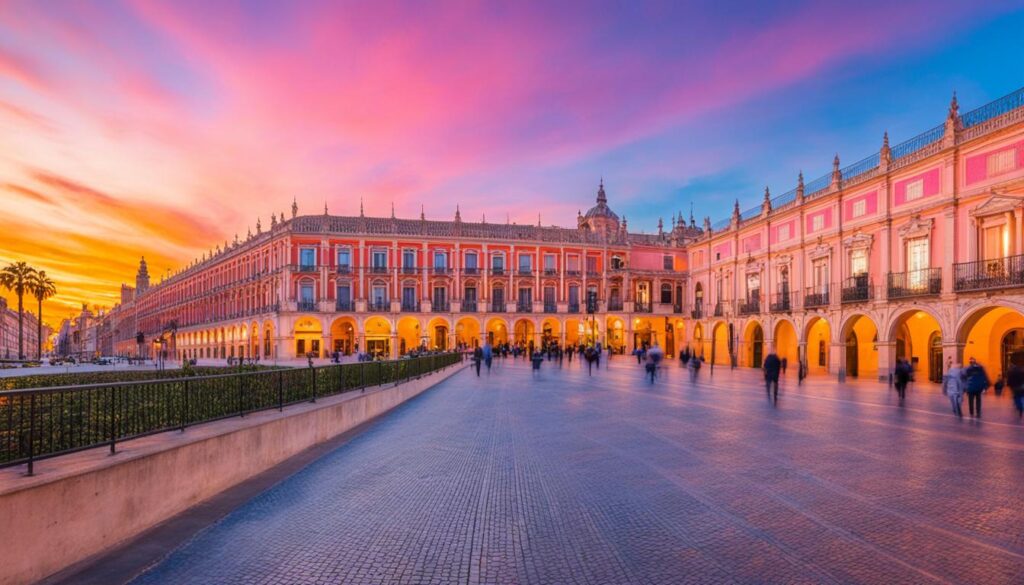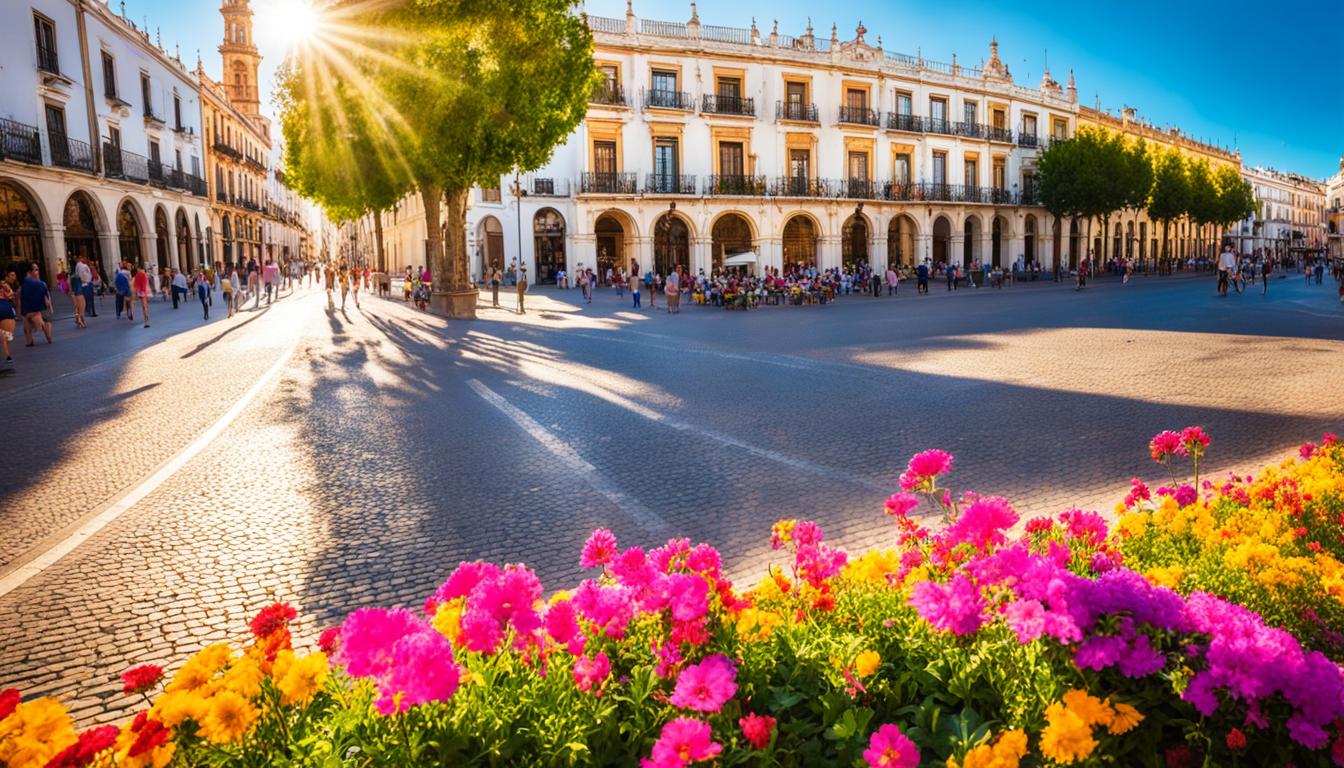Planning a trip to Spain? Seville, the vibrant capital of Andalusia, is a top choice. It’s famous for its history, stunning architecture, and lively culture. Plus, its Mediterranean climate means it’s sunny and warm all year.
Whether you love the sun-drenched plazas, beautiful gardens, or Flamenco shows, knowing Seville’s weather is key. It helps you plan the perfect Spanish trip.
Key Takeaways
- Seville enjoys a Mediterranean climate with hot, dry summers and mild winters
- Temperatures range from highs of 98°F in summer to lows of 42°F in winter
- The city is known for its abundant sunshine and low humidity levels year-round
- Planning your visit to Seville based on the seasonal weather can help you make the most of your trip
- Seville’s sunny and warm climate makes it a popular destination for travelers seeking a Spanish getaway
Warm Mediterranean Climate in Seville
Seville, the heart of Andalusia, Spain, has a Mediterranean climate that draws in those who love the sun. It has hot, dry summers and mild, wet winters. This mix of weather makes it great for visitors all year round.
Scorching Summers and Mild Winters
Seville’s summers are scorching, with highs in the 90s Fahrenheit in July and August. These months are perfect for escaping the cold of Northern Europe. On the other hand, winters are mild, with highs in the 60s and lows in the 40s Fahrenheit.
Low Humidity Levels and Abundant Sunshine
Seville’s dry air, especially in summer, comes from its location on the Iberian Peninsula. The city gets a lot of sunlight all year, with over 2,900 hours annually. This weather makes it ideal for exploring the city’s history and culture.
| Month | Average High (°F) | Average Low (°F) | Rainfall (mm) | Sunshine (hours) |
|---|---|---|---|---|
| January | 61.9 | 42.5 | 78 | 6 |
| February | 65.4 | 44.2 | 69 | 7 |
| March | 71.3 | 48.5 | 52 | 8 |
| April | 75.5 | 52.3 | 58 | 9 |
| May | 83.1 | 58.0 | 43 | 10 |
| June | 91.6 | 64.0 | 16 | 11 |
| July | 97.5 | 68.0 | 0 | 12 |
| August | 97.5 | 68.0 | 5 | 12 |
| September | 89.2 | 64.0 | 36 | 10 |
| October | 79.9 | 58.3 | 64 | 8 |
| November | 69.3 | 49.8 | 82 | 7 |
| December | 63.0 | 45.0 | 75 | 6 |
The table shows Seville’s seasonal temperatures, rainfall, and sunshine hours. It gives a full view of the city’s Mediterranean coastal weather patterns. This data highlights the seville humidity levels and seville seasonal temperatures. It explains why Seville is a top choice for those wanting a mediterranean coastal weather spain experience.
sevilla weather: The Best Time to Visit Seville
Seville, the vibrant capital of Andalusia, has a Mediterranean climate. This climate makes it great to visit all year round. The best time to visit Seville depends on what you like and how you handle the heat.
Spring (March through May) and fall (September through November) are the best seasons. These seasons offer warm weather, low humidity, and fewer people. It’s a top choice for the best time to visit seville.
Winter in Seville is cooler and can be rainy. But, it’s also a good time to visit. You’ll find fewer tourists and lower hotel prices. No matter when you go, you’ll enjoy lots of sunshine and a mild climate.
Festivals and Events
Keep an eye on Seville’s cultural events and festivals. They can change your trip. The Feria de Abril in late April is a big celebration. And Semana Santa (Holy Week) in March is another big event.
| Season | Best Time to Visit | Highlights |
|---|---|---|
| Spring | Late April to early May | Moderate temperatures, lower tourist crowds, Feria de Abril festival |
| Summer | Not recommended | Unbearable heat and humidity, locals travel to coastal areas |
| Fall | September | Cooling temperatures, fewer tourists, good hotel deals |
| Winter | Not recommended | Increased rainfall, chilly temperatures, less vibrant atmosphere |
Think about the weather, events, and what you like to make your visit to Seville memorable and fun.
Spring in Seville: Ideal Weather for Sightseeing
Spring is the best time to visit Seville, Spain. The weather is perfect for sightseeing and outdoor fun. March, April, and May bring mild temperatures, beautiful flowers, and exciting cultural events.
March: Fewer Crowds, Pleasant Temperatures
In March, Seville has nice temperatures from the mid-40s to the low 70s Fahrenheit. This means you can enjoy the city’s sights without the crowds. The air smells of orange blossoms, making everything feel fresh and calm.
April and May: Warmth and Vibrant Festivals
As spring goes on, Seville gets warmer, with highs in the 70s and 80s Fahrenheit. It’s a great time to see Semana Santa (Holy Week) and Feria de Abril (the April Fair). These festivals bring colorful parades, music, dancing, and tasty food.
Spring is the best season to see Seville’s beauty. You can dive into the local celebrations or just enjoy the historic sites. The weather is just right for your adventures.
Summer in Seville: Beating the Heat
Seville’s summers are known for their hot temperatures, often reaching the upper 90s Fahrenheit (36°C) in July and August. But, the dry climate makes the heat easier to handle than in humid places.
To beat the heat, embracing the siesta is key. Take a midday break to rest or by the pool. This helps you escape the sun’s intensity. The best times to see the city are in the mornings and evenings. This is when you can visit famous spots like the Seville Cathedral and Alcazar, both UNESCO World Heritage Sites.
Looking for a cool place? Seville has many museums. Check out the Bellas Artes, Hospital de los Venerables, Casa de Pilatos, and Palacio de las Dueñas. These places offer a break from the heat.
Outdoor lovers can try kayak tours or relax in shady parks. At sunset, the city buzzes with life. Enjoy bars and restaurants with gazpacho, salmorejo, and chilled drinks to cool down.
For a bigger break, day trips to Cádiz, Huelva, or Málaga’s beaches are great. The coastal breeze and water are refreshing. Sanlúcar de Barrameda is a must-see for its manzanilla sherry and beach horse races.
As Seville gets hotter, with forecasts like Morocco’s by 2050, it’s vital to follow the siesta and find cool spots. This way, you can fully enjoy this enchanting Andalusian city.
Fall in Seville: Mild and Comfortable
As summer heat fades in Seville, fall brings mild and comfy weather. September is still warm, with highs in the 80s Fahrenheit. But, humidity drops, making days feel nicer.
September: Lingering Summer Heat
In September, Seville has an average high of 89 degrees Fahrenheit and a low of 64 degrees. The sunny days and clear skies are perfect for visiting historic sites and outdoor spots. The summer crowds start to leave, too.
October and November: Perfect for Outdoor Activities
October and November bring even nicer weather to Seville, with temperatures in the 70s to 60s Fahrenheit. It’s great for eating outside, walking through lively areas, or enjoying beautiful gardens and plazas. Even though it might rain a bit, Seville usually has sunny and dry days perfect for sightseeing.
“The mild and comfortable seville october weather and seville november weather make it an excellent time to visit Seville and enjoy the city’s outdoor charms.”
Fall is a great time to visit Seville if you want to escape the cold or experience its culture and architecture. With warm summer vibes and comfy temperatures, Seville invites you to dive into its history, art, and Mediterranean charm.
Winter in Seville: A Sunny Escape
While much of Europe is cold in winter, Seville is a sunny escape. This city in southern Spain has a mild seville winter weather. It’s perfect for those looking for a warm getaway.
In winter, seville winter temperatures go from about 7°C (45°F) at night to 16°C (61°F) during the day. With 5 hours of sunshine daily, you’ll have plenty of daylight for exploring.
Seville’s climate means it gets less rain in winter, especially in January and February. This dry weather is great for seeing the city’s sights. Visit the UNESCO-listed Alcazar palace and the beautiful Seville Cathedral.
Winter is also a good time to visit because there are fewer people. You can find deals on flights, hotels, and tickets. Enjoy the city’s museums, markets, and outdoor activities without the crowds.
Looking for a break from the cold or just a sunny escape? Seville’s seville winter weather and mild seville winter temperatures are perfect. Dive into the city’s culture, try its tasty food, and enjoy the Mediterranean sun. All while the rest of Europe is cold.

What to Wear in Seville by Season
Packing the right clothes is key to enjoying Seville’s weather all year. Whether it’s the hot summers or mild winters, the right outfit makes a big difference. It helps you stay comfortable and lets you fully enjoy this lively Spanish city.
Layering for Spring and Fall
In spring and fall, Seville’s weather changes a lot from morning to night. Begin with light long sleeves or a sweater. Then, add a light jacket or scarf as it gets cooler. Layering your clothes is the best way to handle the weather shifts.
- Choose fabrics like cotton and linen that breathe well and can be easily changed.
- Carry a versatile scarf or shawl to stay warm when it gets chilly.
- Good walking shoes are a must for seeing Seville’s beautiful streets and areas.
Lightweight and Breathable for Summer
Seville gets very hot in summer, often over 104°F (40°C) in July and August. To stay cool, wear light, breathable clothes like cotton and linen.
- Wear shorts, skirts, and sleeveless tops during the day.
- Use a thin cardigan or shawl for cooler evenings.
- Choose open-toe, comfy shoes that let your feet breathe.
Regardless of the season, wearing versatile and breathable clothes helps you enjoy Seville to the fullest. You’ll stay comfortable as you explore this beautiful Andalusian city.
Seville’s Rainfall Patterns and Daylight Hours
Seville has a warm Mediterranean climate with a nice balance of rain and daylight all year. Knowing about these patterns helps visitors plan their trips. This makes the most of their time in this beautiful Spanish city.
Seville doesn’t get much rain, especially in October and December. These months see about 1.21 inches and less than an inch of rain, respectively. But, July and August are very dry, almost no rain at all.
The daylight hours change a lot with the seasons. From 9.4 hours in December to 14.4 hours in June. This means lots of sunlight for enjoying Seville’s outdoors and sights. It’s perfect for those looking for a sunny getaway.
| Month | Rainfall (inches) | Daylight Hours |
|---|---|---|
| January | 0.98 | 9.7 |
| February | 0.87 | 10.7 |
| March | 0.71 | 11.8 |
| April | 1.02 | 12.9 |
| May | 0.43 | 13.9 |
| June | 0.12 | 14.4 |
| July | 0.01 | 14.2 |
| August | 0.04 | 13.3 |
| September | 0.35 | 12.2 |
| October | 1.21 | 11.1 |
| November | 1.14 | 10.1 |
| December | 0.83 | 9.6 |
Knowing about Seville’s rainfall patterns and daylight hours helps visitors plan their trips. This ensures a memorable and fun experience in the city.

Conclusion
Seville’s warm, sunny climate makes it a top choice for visitors. The city shines in spring, fall, or summer with plenty of sunshine. Mild temperatures and low humidity levels make it easy to enjoy the historic streets and landmarks.
With over 300 days of sunshine, Seville welcomes visitors all year. Spring brings mild temperatures and blooming parks. Summer is hot but siesta breaks and air-conditioned spots offer relief.
Seville’s climate suits every traveler. Planning your visit with the weather in mind ensures a memorable trip. This Spanish city offers a unique blend of sunshine, culture, and history.

